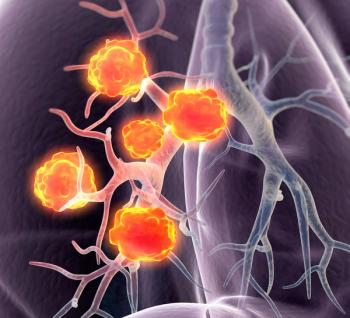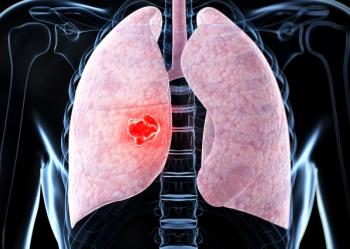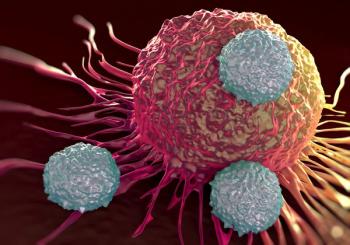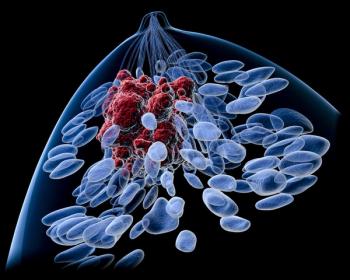
Oxygen-Enhanced MRI May Reduce Radiotherapy Exposure in Tumors with Hypoxia
A clinical trial evaluated the ability of oxygen-enhanced MRI-derived hypoxic volume to detect radiotherapy-induced hypoxia modification.
Oxygen-enhanced (OE)-MRI, a scan involving patient inhalation of 100% oxygen, may reduce the need for radiotherapy exposure in primary and nodal solid tumors with hypoxia, according to findings from a trial (NCT03646747) evaluating the ability of OE-MRI–derived hypoxic volume to detect radiotherapy-induced hypoxia modification published in Clinical Cancer Research.1
Results reveal hypoxia was identified from OE-MRI in all lesions. Median hypoxic volume, which was 10.3 cm3 (IQR, 5.7-24.6) at baseline, was reduced to 6.9 cm3 and 5.9 cm3 at weeks 2 and 4, respectively (P < .001). Additionally, hypoxic volume was reduced in 54.5% and 88.2% of individual lesions by weeks 2 and 4, respectively. Furthermore, all lesions with hypoxic reduction by week 2 saw sustained shrinkage through week 4, implying dose de-escalation may be performed for some patients before week 4 of radiation-based therapy.
“Cancers can be destroyed by radiation and chemotherapy, but the problem is healthy tissues and organs can be destroyed as well,” Michael Dubec, MD, principal clinical scientist of the Division of Cancer Sciences at the University of Manchester, as well as at the Christie Medical Physics and Engineering at The Christie NHS Foundation Trust, stated in a news release on the study findings.2 “Our aim is to destroy the tumor while preserving healthy tissue thus reducing toxicity. Using oxygen-enhanced magnetic resonance imaging to map hypoxia in patients’ tumors may improve the accuracy of their treatment. Now that we have proved the principle, we hope to move on to clinical trials so it can be validated on greater numbers of patients.”
The trial enrolled 27 patients with confirmed p16-positive PV-associated oropharyngeal carcinoma (OPC). Twenty-four patients were eligible for analysis, after 1 had no measurable disease on MRI, another had protocol deviations at baseline, and another had baseline gas inhalation. Within the patient cohort, the median age was 67 years (IQR, 59-75), 21 patients were male, and 15 had tumors in their tonsils.
MRI was performed on either a 1.5 T diagnostic MR or a 1.5 T MR Linac system. Patients underwent MR imaging prior to radiotherapy followed by scans at week 2 and/or 4 into treatment with radiotherapy. A patient subset underwent 2 pretreatment scans 1 week apart to enable repeatability assessment. Patients received between 55 Gy in 20 fractions to 70 Gy in 35 fractions of prescribed radiotherapy and were given concurrent platinum-based therapy if eligible.
The mean number of days between baseline imaging sessions was 6 (standard deviation [SD], 2). Additionally, there were an average of 12 days (SD, 4) and 30 days (SD, 8) from radiotherapy start to imaging at weeks 2 and 4, respectively.
In total, 44 lesions were included in the main study, with baseline hypoxic ranging from 1.3 cm3to 82.1 cm3. Of evaluable patients having undergone both baseline scans (n = 12), median hypoxic volume at the 2 timepoints were 16.0 cm3 (IQR, 6.4-36.0) and 10.5 cm3 (IQR, 6.6-43.6), with a within-subject coefficient of variation of 24.6% and an asymmetric upper and lower limits of agreement on repeatability coefficient of –45.7% and 84.1%, respectively.
At week 2, 58.8% (n = 10/17) and 50% (n = 8/16) of primary tumors and nodal lesions experienced a reduction in hypoxic volume. Additionally, at week 4, a greater incidence of hypoxic volume change was observed in 6 of 8 primary tumors (75.0%) and all nodal lesions. Of 36 lesions evaluated at week 2 and/or 4, 72.2% (n = 26/36) experienced a reduction in hypoxic volume by their last scan.
References
- Dubec MJ, Price J, Berks M, et al. Oxygen-enhanced MRI detects incidence, onset and heterogeneity of radiation-induced hypoxia modification in HPV-associated oropharyngeal cancer. Clin Cancer Res. Published online August 15, 2024. doi:10.1158/1078-0432.CCR-24-1170
- New method could lower radiotherapy doses for some cancer patients. News release. The Institute of Cancer Research. August 14, 2024. Accessed August 22, 2024. https://tinyurl.com/3zwrrcwh
Newsletter
Stay up to date on recent advances in the multidisciplinary approach to cancer.

















































































